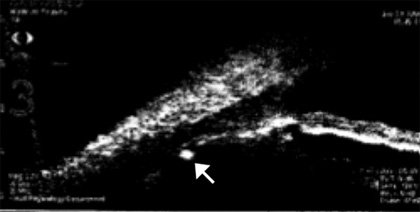Loss of Vision after Cataract Surgery and Implant Exchange Surgery
Ophthalmic History
The patient underwent cataract surgery with a first-generation multifocal zonal refractive IOL approximately 7 years earlier. Following her multifocal IOL implantation, she had severe halo and glare symptoms that precluded her from driving. A Nd-YAG capsulotomy was performed, but her symptoms did not improve.
The patient later sought a second opinion and underwent IOL exchange with placement of a 6.5-mm optic 3-piece monofocal IOL in the sulcus. At the time of her IOL exchange surgery, a limited vitrectomy was required because of an opening in her posterior capsule from the Nd-YAG capsulotomy.
Following the IOL exchange, her vision improved to 20/20, and she no longer had nighttime dysphotopsias. The patient’s vision was stable until her current presentation.
Clinical Examination
Slit lamp examination of the patient’s right eye was unremarkable except for quiet pseudophakia. The patient had undergone monofocal cataract surgery in this eye previously. Vision in the right eye was 20/25 with an IOP of 19 mm Hg.
The patient had hand movement vision in her left eye. No afferent pupil was noted. IOP measured 20 mm Hg.
The anterior segment in the left eye was quiet with a 3-piece IOL present in the sulcus. The lens appeared to be in good position. The red reflex was decreased.
Fundus examination in the right eye was normal. In the left eye, a dense vitreous hemorrhage was present. B-scan ultrasonography confirmed the vitreous hemorrhage and also suggested the presence of a small peripheral detachment and tear.
Initial Management and Clinical Course
Retinovitreous consultation was obtained due to a concern that the dense vitreous hemorrhage was secondary to a retinal tear with subsequent early detachment. A pars planavitrectomy (PPV) was performed to clear the blood and to enable treatment of any precipitating retinal tear or detachment that might be present.
At the time of surgery, a dense vitreous hemorrhage was confirmed but no retinal pathology was noted. The patient’s vision improved to 20/20 postoperatively. However, 10 days following her PPV, she had a second vitreous hemorrhage, which was not as dense as the previous hemorrhage. She was observed clinically. Her vision returned to normal in approximately 4 days.
Over the next 3 weeks, she had 4 additional spontaneous vitreous hemorrhages. An ultrasound biomicroscopy (UBM) examination was performed that revealed one of the haptics of her sulcus-fixated IOL was impinging the posterior iris (Slide).
|
The patient was diagnosed with uveitis, glaucoma, hyphema (UGH) syndrome. She was treated with a course of cycloplegia to dilate the pupil and to diminish the haptics/uveal chafe to allow the iris to heal. The patient had two additional vitreous hemorrhages in the first week that cycloplegia was instituted, and she did not think that she could continue with the therapy.
A discussion was held with the patient regarding the etiology of her symptoms and potential surgical options. It was explained that the simplest approach would be to try and rotate the IOL in the sulcus away from the region of the chafe. She understood that if this did not ameliorate her symptoms, then a more invasive procedure would be necessary.
The patient underwent IOL rotation under topical anesthesia and has not had a subsequent vitreous hemorrhage for more than 6 months.
Discussion
In 1978, Ellingson1 reported on patients with first-generation anterior chamber IOLs who developed UGH caused by mechanical contact between the IOL and uveal tissue. He described multiple causes such as rough edges to the manufactured materials, rigid closed-loop haptics, and lens sizing complications. This clinical syndrome was also seen with iris clip lenses. Although less frequently, UGH can be seen with posterior chamber IOL (PC-IOL) in the sulcus as well as IOL decentration.2
In many cases, the hyphema can occur from direct mechanical chafing of the iris from the PC-IOL.3 Cases of UGH syndrome years after initial surgery have been reported. Some clinicians have termed UGH syndrome associated with vitreous hemorrhage UGH plus; patients who present with bleeding but no other associated symptoms may be said to have incomplete posterior UGH.
A staged approach to the management of this complication is suggested. Some patients will respond to conservative treatment with observation, cycloplegia, and anti-inflammatory and glaucoma agents as needed. Cycloplegia causes the iris to move anteriorly away from the lens haptics and lessen or stop the uveal chafe. Preventing the movement of the iris with cycloplegia also lessens uveal chafe. Topical anti-inflammatory agents and glaucoma medications will treat inflammation and elevated IOP until the mechanical irritations from the uveal chafe resolves. Patients who are recalcitrant to conservative treatment may require lens repositioning or even IOL exchange.4
References
- Ellingson F. Complications with the Choyce Mark VIII anterior chamber lens implant (uveitis–glaucoma–hyphema). J Am Intraocul Implant Soc. 1977; 3:199-201.
- Masket S. Pseudophakic posterior iris chafing syndrome. J Cataract Refract Surg. 1986; 12:252-256.
- Pavlin C, Harasiewicz K, Foster F. Ultrasound biomicroscopic analysis of haptic position in late-onset, recurrent hyphema after posterior chamber lens implantation. J Cataract Refract Surg. 1994; 20:182-185.
- John G, Stark W. Rotation of posterior chamber intraocular lenses for management of lens-associated recurring hyphemas. Arch Ophthalmol. 1992; 110:963-964.

